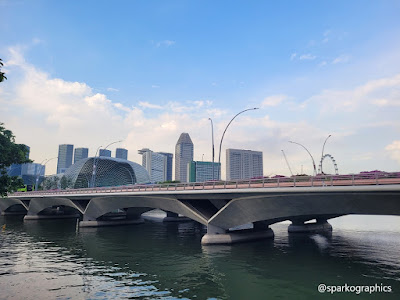At the end of my inspiring walk along the historic Singapore River and through the skyscraper-filled Central Business District, I finally arrived at my destination, the Merlion Park by the Marina Bay. This is where the world-famous Merlion statue stands, a beloved symbol of Singapore. The Merlion was specially created as a national icon by the Singapore Tourist Promotion Board (STPB, now known as the Singapore Tourism Board) in 1964. The emblem was originally conceptualized by a British ichthyologist Alec Fraser Brunner, then curator of the now-demolished Van Kleef Aquarium, and served as the official logo of STPB from 1964 to 1997. The iconic statue itself was designed by Kwan Sai Kheong, then Vice-Chancellor of the University of Singapore, and sculpted by local artist Lim Nang Seng. Standing 8.6 meters tall, the Merlion here is the most famous representation of the national symbol. However, it’s not the only one. In fact, the Singapore Tourism Board recognizes at least five official Merlion statues (some sources mention six or even seven) including one at Mount Faber and another one Tourism Court, and here in Merlion Park, there is also a smaller, 2-meter-tall Merlion Cub nearby. Interestingly, many tourists who come to admire and photograph the Merlion may not realize that this iconic statue is no longer standing at its original location.
 |
| Recognized around the globe, the Merlion is the enduring symbol of Singapore |
 |
| As a popular tourist destination, the Merlion is visited by millions of people each year |
The iconic Merlion statue was officially unveiled on 15 September 1972 by Prime Minister Lee Kuan Yew, after nearly a year of construction. Originally, the Merlion stood at the mouth of the Singapore River, where the original Merlion Park was located. However, the completion of the Esplanade Bridge in 1997 obstructed the statue’s visibility from the Marina Bay waterfront. To restore its prominence, the Singapore Tourism Board (STB) decided to relocate the statue in 2002. After evaluating several possible sites, a new home was chosen just 120 meters away, on a newly reclaimed pier in front of the Fullerton Hotel, across the Esplanade Bridge. The relocation project also involved expanding the park to nearly four times its original size. On 15 September 2002, exactly 30 years after the statue’s first unveiling, Senior Minister Lee Kuan Yew returned to officiate the Merlion’s new location. Interestingly, the statue still faces east—just as it did in its original position—following traditional Feng Shui (Chinese geomancy) principles, which regard that direction as particularly auspicious. From the newly built viewing deck over the river, visitors can now capture photos of the majestic, water-spouting creature with the city's skyscraper skyline as a dramatic backdrop. The Merlion remains one of Singapore’s most photographed landmarks, drawing millions of visitors each year. Its popularity is so iconic that countless souvenirs from keychains and T-shirts to plush toys and fridge magnets featuring the Merlion can be found in shops all across the island.
 |
This photo was taken during my previous visit in 2014, capturing the Merlion and the distinctive Esplanade
|
 |
| The construction of this Esplanade Bridge led to the relocation of the statue |
So, why is Singapore’s most iconic symbol a creature with the head of a lion and the body of a fish? While many cultures have their own legends of mythical sea beasts, the Merlion is uniquely tied to Singapore’s historical and cultural roots. The fish tail symbolizes Singapore’s origins as a humble fishing village on the southern tip of the Malay Peninsula, while the lion head represents the city’s legendary founding. According to local legend, in 1299, a Sumatran prince named Sang Nila Utama, believed to be from the Srivijaya Kingdom based in Palembang, Indonesia landed on the island then known as Temasek, a name possibly derived from the Old Malay word tasik, meaning “lake” or “sea.” Historical texts such as the Nagarakretagama, a 14th-century Javanese eulogy, also mention the island as Tumasik. During his visit, Sang Nila Utama reportedly encountered a strange animal, which local guides told him was a lion, an auspicious sign in many cultures. Inspired, he renamed the island Singapura, which means “Lion City” in Sanskrit, and established a settlement that would later evolve into the ancient Kingdom of Singapura. The Merlion, combining these two symbols—the lion for strength and identity, the fish for heritage and origin—was created as a visual embodiment of Singapore’s story. The idea was conceived by the Singapore Tourist Promotion Board (now the Singapore Tourism Board) in the 1960s as a marketing emblem to represent the nation. The result was a uniquely Singaporean creature: part myth, part history, and entirely iconic.
 |
| The Merlion faces Marina Bay Sands, an iconic meeting of Singapore’s heritage and modern skyline |
Beyond being a national symbol, the Merlion has also become a pop culture icon. Its likeness appears everywhere—on souvenirs, artworks, and even desserts—making it one of the most recognizable figures associated with Singapore around the world. Today, the Merlion stands proudly at its new home in Merlion Park, gazing out across Marina Bay toward another architectural marvel—Marina Bay Sands. Completed in 2010, this integrated resort complex is instantly recognizable by its three soaring towers topped with a unique SkyPark shaped like a ship. Housing a luxury hotel, convention center, shopping mall, museum, and the iconic infinity pool, Marina Bay Sands has become a symbol of Singapore’s modern ambition and global status. As the Merlion looks out toward this skyline of progress, it serves as a reminder of how far Singapore has come—from its humble fishing village origins to the world-class city it is today.
Singapore Merlion
Merlion Park
Location 1 Fullerton Road, Singapore
Opening Hours
Daily, 24 hours (public areas)
Shops and eateries may have their own operating hours





Comments
Post a Comment